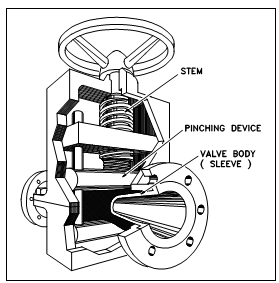Pinch Valves
The associatively inexpensive pinch valve, described in Figure, is the easiest in any valve design. It is easily an industrial version of the pinch cock used within the laboratory to control the flow of fluids by rubber tubing.
Pinch valves are suitable for on-off and throttling services. Therefore, the effectual throttling range is commonly among 10 percent and 95 percent of the rated flow capacity.
Pinch valves are ideally suited for the handling of slurries, liquids along with large amounts of suspended solids, and systems which convey solids pneumatically. Since the operating mechanism is fully isolated from the fluid, those valves also search application whereas corrosion or metal contamination of the fluid may be a problem.
A pinch control valve consists of a sleeve molded of rubber or other synthetic material and a pinching mechanism. The whole of the operating portions are fully external to the valve. A molded sleeve is referred to as the valve body.
Pinch valve bodies are manufactured of natural and synthetic plastics and rubbers that have good abrasion resistance properties. Those properties allow little damage to the valve sleeve, through giving virtually unimpeded flow. Sleeves are available along with either extended hubs or clamps designed to slip over a pipe end, or along with a flanged end having standard dimensions.

Figure: Pinch Valves